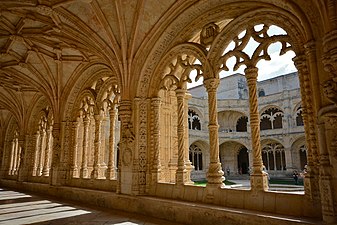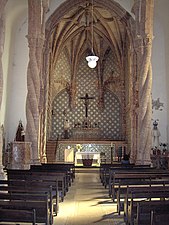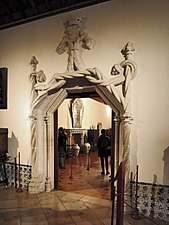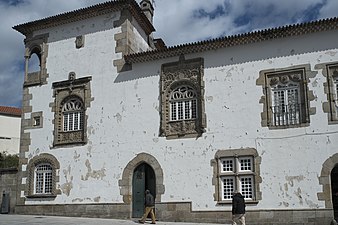Manueline


The Manueline (also Emanuelstil , Manueline style or Emanuelismus is called) an ornate style of architecture only in the Kingdom of Portugal occurred in the early 16th century. The Manueline is named after King Manuel I (r. 1495–1521), who was in power during Portugal's economic and cultural heyday. The concept of style manuelino was introduced by the historian Francisco Adolfo de Varnhagen in his writing Notícia Histórica e Descriptiva do Mosteiro de Belém from 1842.
Stylistic classification
Manueline is the earliest Portuguese colonial style , and can be viewed as a special form of late Gothic or a mixed style between Gothic and Renaissance , which was expanded to include Spanish, Italian, Flemish style elements and maritime ornaments such as ship cordons. In some cases, elements of Mudejar art and the early Italian Renaissance were also adopted, such as B. round arches instead of Gothic pointed arches (e.g. in Santa Maria de Belém or the Conceiçao Velha in Lisbon) or columns instead of pillars. The style thus corresponds to the essence of other styles of the late Gothic, especially the Isabelline and Plateresque styles in Spain, but also the Flamboyant in France and England.
The Manueline style was inspired by the journeys of the seafarers Vasco da Gama and Pedro Álvares Cabral , whose discoveries and conquests made Portugal particularly wealthy at the time; Sometimes an African or Indian influence is assumed (e.g. for the Capelas imperfeitas in Batalha ). In addition to the twisted rope and seaman's knot mentioned above, there are a number of characteristic motifs, which often come from heraldry or from Christian and alchemical symbolism :
- the armillary sphere , an astronomical instrument which symbolized a claim to world domination and which was an emblem of the Portuguese kings John II and Manuel I ;
- the cross of the Christ Knights, the most important knightly order in Portugal, which also had a close connection to the Portuguese royal family;
- naturalistic motifs such as branches , foliage (e.g. laurel or ivy ), flowers, thistles , artichokes , fruits such as pomegranates and the like. Ä .;
- maritime motifs such as corals , shells or algae ;
- Animals and human figures;
- fantastic or grotesque figures and hybrid creatures, such as mermaids or sirens , ouroboros, etc. a.
In the craftsmanship of all these decorative forms, a tendency to soften and round is noticeable (not to high and pointed like in the Gothic). The lush ornamentation mainly adorns portals and windows, but also walls and roofs, it adorns monasteries, churches and palaces and even pillars of shame ( Pelourinhos ).
The Manueline style lives on in the embellishments of Portuguese, Spanish , Mexican, and colonial Indian art that it influenced.

buildings
Much of the Manueline buildings were destroyed in the great Lisbon earthquake in 1755 . The most important and splendid examples of Manueline art are the Torre de Belém and the neighboring Jeronimos Monastery with its cloister in Lisbon, as well as the Batalha Monastery and parts of the Christ Monastery in Tomar - here is u. a. a famous window of the chapter hall, richly decorated inside and out with plastic, interwoven ship cordage and natural motifs. The famous church of the Convento de Jesus in Setúbal , with pillars in the form of huge twisted ropes, is also considered to be one of the earliest examples of Manueline art . In Lisbon, the facades of the Church of Nossa Senhora da Conceição Velha and the Convento da Madre de Deus (today: Museu Nacional do Azulejo ) are still preserved in a purely Manueline style, in Coimbra the facade of the Capela de São Miguel of the University and parts of the Mosteiro de Santa Cruz , in particular the church portal and the cloister - the latter, however, much simpler than the cloisters of Belém and Batalha. Particularly noteworthy are the main churches ( Igreja Matriz ) of Golegã , Vila do Conde , Viana do Alentejo , and the São Julião church in Setúbal, all with splendid, typically Manueline portals.

Significant examples of secular architecture can be found at the old Royal Palace ( Palácio Nacional ) in Sintra , or at the Casa dos Coimbras in Braga . The Palácio Real of Évora , which was greatly expanded by Manuel I, was once famous, but only a small part of it has survived.
In addition, examples of the Manueline style can also be found in smaller churches or buildings throughout Portugal with its overseas territories ( Madeira , Azores ), for example in the Azores the Igreja Matriz de São Sebastião church (portals) and parts of the town hall of the city of Ribeira Grande . From the former colonies of Portugal or former trading establishments, the churches of São Francisco and the Priorado do Rosário in Goa should be mentioned (today World Heritage ). Some buildings, although built at the time of Manuel I, show only very few elements in the Manueline style, for example the cathedral of Funchal on the island of Madeira, the remains of the so-called 'Portuguese chapel' ( Chapelle Portugaise ) in the Moroccan port city of Safi , or the Capela de Nossa Senhora do Baluarte , built in 1522 on the island of Mozambique .
Representative
Important representatives of this style were João de Castilho and Diogo Boitaca , who are famous for the monastery area of the Hieronymites Monastery , and Francisco and Diogo de Arruda , who designed the Torre de Belém on the banks of the Tagus in Lisbon . In painting, the by name unknown master von Sardoal is considered a representative of Manueline art.
- Manueline in sacred architecture
South portal and facade of the Church of Santa Maria de Belém , Mosteiro dos Jerónimos , Belém (Lisbon)
Cloister of the Mosteiro dos Jerónimos, Belém
Vault of the main chapel of the Mosteiro dos Jerónimos, Belém
Portal of the unfinished chapel of the Batalha Monastery
Igreja de Jesus with pillars made of twisted ropes in Setubal
- Manueline in profane architecture
Manueline windows on a facade of the Palácio Nacional de Sintra
Casa dos Coimbras in Braga (lower right window with cordage)
Remains of the Palácio Real in Évora
Manueline window of the town hall of Ribeira Grande , Azores
See also
literature
- Francisco Adolfo de Varnhagen : Notícia Histórica e Descriptiva do Mosteiro de Belém. Lisboa 1842. ( archive.org ).
Web links
Individual evidence
- ^ "Emanuelstil", in: Lexikon der Kunst , Volume 4, Karl Müller Verlag, Erlangen 1994, p. 151.
- ^ "Emanuelstil", in: Lexikon der Kunst , Volume 4, Karl Müller Verlag, Erlangen 1994, p. 151.
- ^ "Isabellinischer Stil", in: Lexikon der Kunst , Volume 6, Karl Müller Verlag, Erlangen 1994, p. 190.
- ^ "Emanuelstil", in: Lexikon der Kunst , Volume 4, Karl Müller Verlag, Erlangen 1994, p. 151.
- ↑ Stéphan Szeremeta: Açores. P. 103, Paris 2014.
- ↑ see Capela de Nossa Senhora do Baluarte , Portuguese Wikipedia










